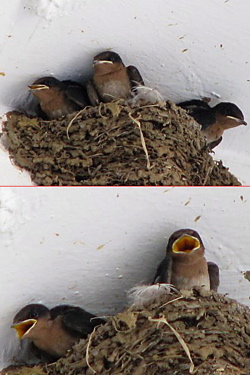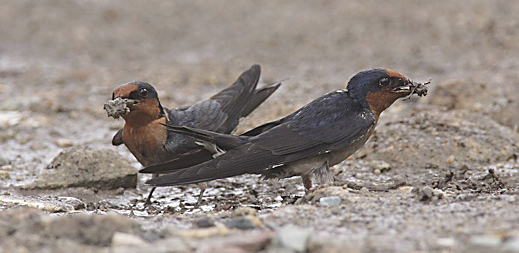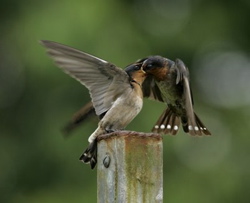In the Urban Forest blog, Siyang relates his encounter with a Pacific Swallow’s (Hirundo tahitica) nest complete with three chicks. The nest was plastered to a wall in a lonely corner of the National University of Singapore’s Kent Ridge campus (left).
“… a cup shaped nest made of mud with the inside lined with soft bedding-like feathers. Three little heads looked down at me when I was curiously looking at it. Baby swallows!
“The parents dun take kindly to passersby. It attacked Juanhui (missing by inches), directly at Lionel and me (had to duck away) when we walked pass below the nest on separate occasions. Still, I do hope those chicks survived and fly free in the sky soon.”
These Pacific Swallows are common residents in Singapore. They are seen all over the island and have no problems nesting around human habitation. They build their nests around the first half of the year. The nest is a half-cup made of mud stuck to a rough vertical surface, in this case the wall of a building structure.
Both partners assist in mud collection, digging the damp mud with their bill and transporting the pellets back to the nesting site (below). There, the mud is stuck to the vertical surface to create a base from which the side of the nest is developed. Numerous trips are needed before the nest is finally completed in a few days to a few weeks.
The mud is often mixed with vegetable fibres and the nest is lined with dry grass, lichens and feathers. In the case of feathers, they are often caught in flight or collected from the surface of water-bodies.
These nests are recycled year after year after some repairs.
The bird lays a clutch of two to three eggs with the female incubating them for 17-22 days. The chicks have characteristic pale yellow oral flanges enclosing the orange mouth cavity (top). These function as targets for the adults feeding the chicks. This is also seen in Eurasian Tree Sparrow (Passer montanus) and Oriental White-eye (Zosterops palpebrosus).
The food brought for the chicks are in a compressed ball of insects. A ball may serve more than one chick when they are young but as they get older, each may be fed a ball of insects. It take about 20 days for the chicks to fledge, after which they return to the nest at night for several more days. The feeding of the juveniles (right) has been posted earlier.
Some of these swallows have been recorded to live up to seven years.
Siyang
Singapore
July 2007
(Images: Siyang (nest with chicks) and Chan Yoke Meng (collecting mud and feeding juveniles).
References:
Spittle, R.J. (1949). Nesting habits of some Singapore birds. Bulletin of the Raffles Museum 21:184-204.
Turner, A. K. (2004). [‘Family Hirundinidae (Swallows and Martins)’]. Pp. 602-685 in del Hoyo, J., Elliott, A. & Sargatal, J. eds. Handbook of the birds of the world. Vol. 9. Cotingas to Pipits and Wagtails. Barcelona: Lynx Editions.











